- Working at KSC
- NASA Old Headquarters building on KSC destroyed.
- Flintknapping points
- Vampires of Kennedy Space Center and the O&C
- Demons of Kennedy Space Center
- Demons of Kennedy Space Center, corpus callosotomy
- Ghosts of Kennedy Space Center, End of Spiders
- Dreams of Kennedy Space Center, lovers and pyramids.
- Witches of Kennedy Space Center
- Cave Bears of Kennedy Space Center
- Aliens of Kennedy Space Center, uninvited guests
- Remembering Kennedy Space Center
- Lake 33 Killing Relic
The MR340 is a “human powered” endurance boat race across Missouri with an 88 hour time limit and 8 mandatory check points. Sleep is optional and at whatever location the exhausted participants choose to rest.
Delay of the 2019 MR340 due to flooding

88 hours of mud and heat.
A story

MR340 racers and support crew waiting to get into the water at Kaw Point park Kansas City Missouri

Lining up at Kaw Point for race start
A race across the state of Missouri……
From the MR340 river race website:
“Imagine a race across the entire state of Missouri, just you and your boat thrown against 340 miles of wind, heat, bugs and rain. The Missouri 340 is an endurance race across the state of Missouri. Competitors will start in Kansas City and finish, some of them anyway, near St. Louis. Participants are allowed exactly 88 hours to complete the course. Only 2/3 of the teams were able to do that last year.”
Kansas City, Kaw Park, Sunrise
Video drones whirled over the congested launch points and hovered over the Kansas River filming both anxious racers undertaking last minute adjustments and the cheerful support crews or worried family members gathered under the tall cottonwood trees of Kaw Point.
The rising sun promised another sweltering Midwest summer day, but the growing light to the east also beckoned toward the finish point, 340 miles downstream.
We paddled the two kayaks into the floating crowd of approximately 600 racers sitting in or standing on an amazing assortment of 400 kayaks, canoes and paddleboards to wait for the blast from a Lewis & Clark era brass cannon; the signal that would start the 10th Annual Missouri River 340 race (The MR340)
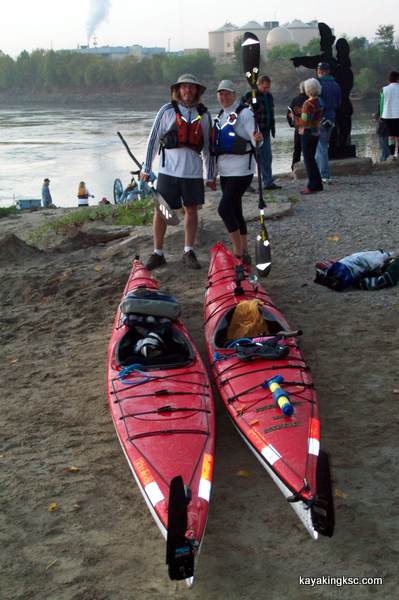
Before the start of our third MR340--all smiles because the heat had not yet arrived for a scorcher summer day.
The MR340 is a “human powered” endurance boat race across Missouri with an 88 hour time limit and 8 mandatory check points. Sleep is optional and at whatever location the exhausted participants choose to rest.
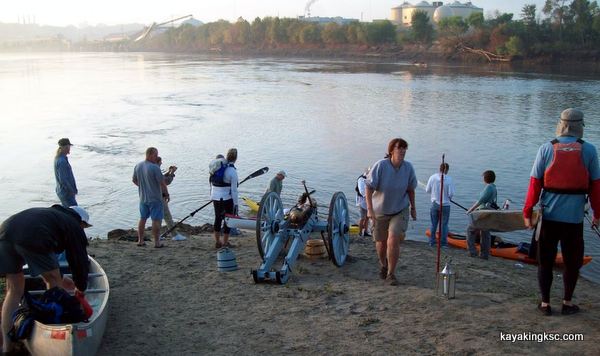
The Kansas and Missouri Rivers meet creating a bumpy confluence.
In the center: the cannon to start the race.
On the left, a classic sturdy aluminum canoe. On the right a modern carbon fiber 'tippy' racing kayak. The MR340 has room enough for both types of adventurers.
At 7am the cannon sounded and the paddlers rushed towards the turbid confluence of the Kansas and Missouri Rivers.
Bunny and I, both veterans of the MR340 pushed our kayaks to the side to let the multitude of excited racers bump and bang their way into the muddy Missouri River.
Knowing from past experience, it was best to make space for both the gifted racers in their sleek carbon fiber racing boats and the overly eager first timer racers-many of them fervently paddling dented aluminum canoes.
In only a few moments the muddy river had grabbed the log jam of boaters and pushed them downstream.
Giving a final wave to the buzzing drones we crossed the bumpy passage out of the slack Kansas River and into the faster flowing Missouri River. Like the other racers we were not immune to the race excitement that was prodding us to paddle faster; however from previous MR340 races we knew the challenge was to actually slow down, calm the race jitters and use our practiced “long distance paddle stroke” that would conserve energy to push us down river all day and well into the night.
After all there was not exactly a requirement to rush when there are 340 miles to paddle and the afternoon temperature was forecast at 98 degrees. Our goal was to set up our first overnight camp at check point #3, near the town of Miami 105 miles downriver.
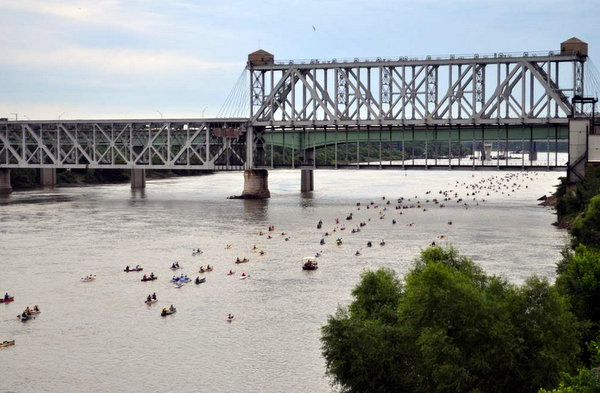
The crowded race start in Kansas City. Only for a few miles and the racers spread out.
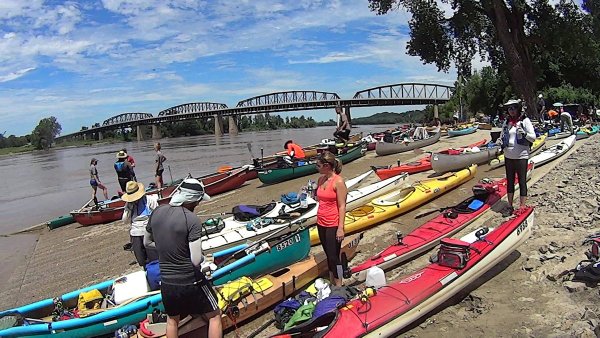
Stretching legs at Glasgow Missouri
The Storm.....
105 weary miles later – the last 30 miles paddled under the full moon we pulled our boats onto the muddy checkpoint #3, to pitch our tent amongst 50 or so other campers; hopeful to catch a few hours of sleep and get back on the river by 4am. Lightning flashes to the north caused concern however there was no cell phone reception to check the NOAA satellite.
Around 2 am an ominous wind began to rustle the cottonwood tree branches, lightning flashes grew brighter and thunder sounded moving ever closer. By 3 am the storm swept over the campsite bringing cold rain and blustery winds that snapped tree limbs to crash amongst the tents.
I got up to check on the kayaks only to witness tired racers scrambling to install rain covers on their tents.
Above the boat ramp I verified the safety of our boats. Even then paddlers with flashlights were just arriving at the check point- vastly relieved to be off the river and I helped three people struggle out of a water filled canoe.
Those of us at Miami were the lucky few -because hundreds of racers up and down river of the check point were caught in gusting winds that capsized boats and lightning forced other paddlers off of the river to scramble up the muddy banks in pitch darkness.
We dragged the canoe up the wet ramp, the wind was gusting so hard I could not even slip on the poncho retrieved from my kayak. “Well this is an adventure” I thought shivering from the cold rain and searching the darkness for a funnel cloud during the windy walk back to the tent.
A Mylar 'space' blanket should be considered mandatory race equipment
At our campsite I discovered a branch had partially collapsed the tent, our rain fly blown off and Bunny sheltering in the passenger seat of a nearby pickup truck.
I crawled into our wet tent and unwrapped a mylar “space” thermal blanket. Curling into the foil blanket, my shivering stopped and I slept until a grey dawn. Surprised at how well I had slept even with my bare feet hanging in the rain. At daylight I found my sandals floating beneath my cot. The campsite was inundated with three inches of water.
Mud? No problem, just a late start to another day of mud. Breaking camp we noticed there were many boats already loaded on vehicles, -racers who had enough of the MR340 experience and were quitting.
At the boat ramp we found at least a dozen racers passed out on the concrete ramp, no tents, no bug repellent, just fatigued. We lifted our kayaks over sleeping bodies and pushed into the river for Day 2 of the race.
For the next 50 miles we observed upended and broken trees and exchanged exciting stories with fellow racers about surviving “The Storm.” Bunny and I ever more thankful that we were not on the water when the storm hit and unlike many others we were actually able sleep a few hours.

Dawn on the Missouri
The plan for day two was to complete another 100+ miles. On the second afternoon we passed the bridge that marked the “Halfway point” This was the same bridge, where during a previous MR340 race we had taken shelter from a fierce hail storm. The farmland next to the bridge under which we had huddled belonged to the grandfather of a former Kennedy Space Center employee. We do indeed live in a small world.
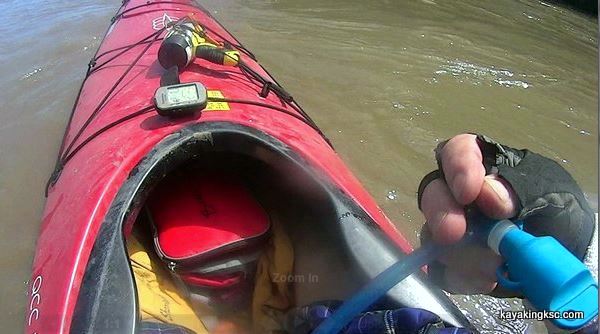
Taking a sip of electrolyte home brew from my Platypus container. In the Photo: Food bag, paddling Kilt, gloves for protection from sun and blisters, a device to measure my paddle speed, towels for both sun protection and to mop the boat. And my mini-spotlight for emergencies while paddling in the dark. The photo must be morning & I have not stowed the light yet.
The third afternoon we reached check point #8 at the town of Herman. There was still at least 4 hours of daylight remaining and an easy 80 miles to the finish line.
However we made the decision to stop and spend a well-deserved evening relaxing on a rise above the river, enjoying both the spectacular sunset and a brilliant full moon that changed the muddy river to silver in the moonlight. Nevertheless, because we were actually in a race, it was bittersweet to observe the boats check in and out of Herman making their night journey towards the finish line.
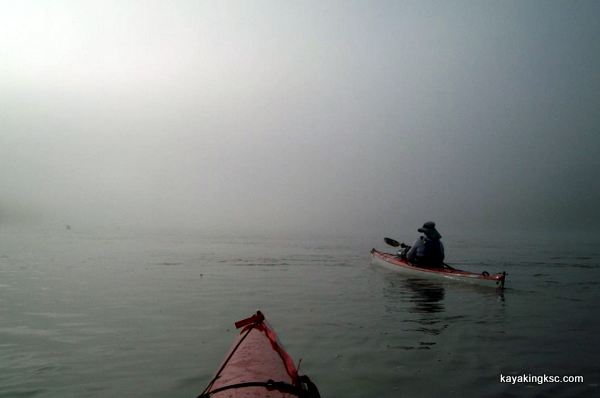
Morning Fog on the Missouri River.
I have to be careful and explain.
At the mandatory MR340 Safety briefing; Scott the person running the race is emphatic that you should NOT paddle in the fog. Just too many hazards.
I agree.
So in the following story I write how we did paddle in the fog.
The only reason I proceeded that year is because the Missouri River was "Just" below flood stage. Consequently the normal paddling hazards: wing dikes, the sand bars, and submerged trees were well under the water. And the Navigation buoys had been swept away.
So accepting a little risk we proceeded slowly down an "obstacle free" river. Wise decision? Probably not however the river was empty. Of course there could have been boats coming up river.....
If the wing dikes had been exposed? We would have absolutely waited the 2-3 hours for the fog to dissipate.
The next morning- and final day of the race, we were again on the river before sunrise however after paddling only a couple of miles in the pre-dawn darkness, we watched with alarm as a huge fog bank blotted out the stars filling the river valley from bluff to bluff.
For the next eleven miles we paddled cautiously nearly blind through the damp fog. The sun rose to the east as a dim pale light illuminating cliffs and wispy tendrils of fog on the swirling river.
At times our visibility was reduced to less than ten feet. Slipping through the extensive fog bank we passed many of the paddlers that we had seen continue on from Herman the evening before. Many had been stranded in the fog nearly all night, attempting to sleep in their boats waiting for an interruption in the whiteness.

The Bridges of St. Charles Missouri signaled were close to the finish line.
In the afternoon approaching the finish line near the city of St. Charles we counted off the bridges that marked the end of the race. The five bridges upstream of the finish line were both a welcome sight and at the same time somehow disappointing- signifying the end to our four day adventure.
Rounding the last river bend in sight of the finish line we watched incredulously as a canoe in front of us continued on past the packed shore--the exhausted racers in the canoe not even realizing they had completed the 340 mile race! The crowd on shore began to yell and we watched as the canoe laboriously turned around and began the paddle upstream.
When we reached the flag marking the finish and were helped out of our kayaks, receiving water, congratulations and pats to the back.
I asked Bunny if she would be willing to enter the next MR340?
Her response was a firm “Never again.”
Never say never I thought......
Drone footage of the race start and fog delays can be found on youtube: “MR340 Floating Dreams”
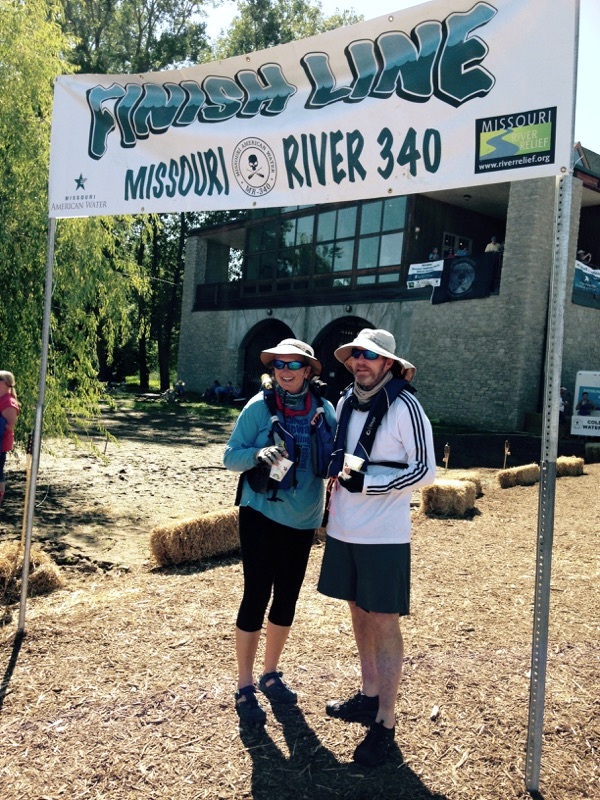
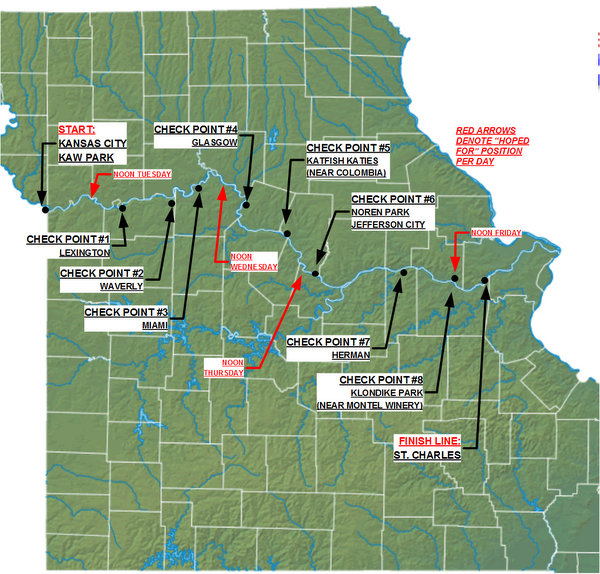
I made this map of the MR340 race.
List the checkpoints and our goal of for each day. This is the "easy" race pace in which we sleep for six hours a night. This easy pace also brings to the finish line in nearly last place.
Why enter the grueling MR340 race with 600 other hopeful finishers?

Return home from 88 hours of paddling
Kayakingksc.com
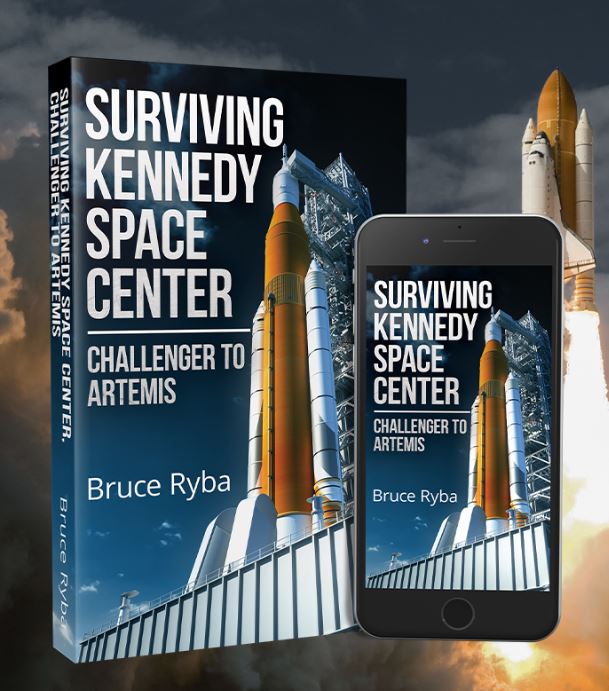
My next book!! "Surviving Kennedy Space Center"
on Amazon.
Peek behind the curtains of the Shuttle and Artemis programs.
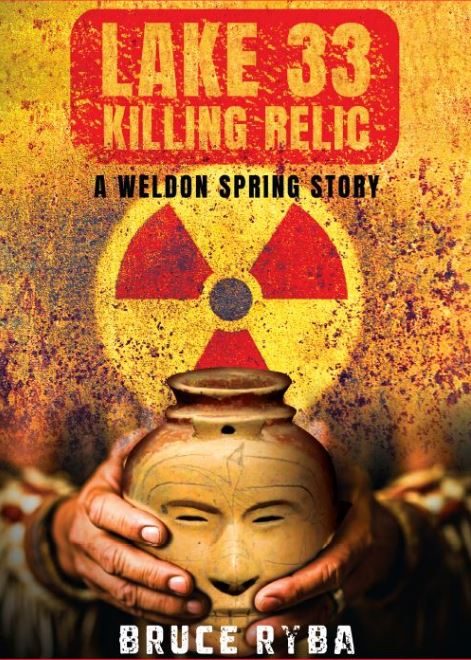
(Second to newest) My newest book, available on Amazon
(paperback and e-book)
For pet lovers around the globe, "It's a Matter of Luck" is a collection of heart warming stories of horse rescues from the slaughterhouse.
Available on Amazon
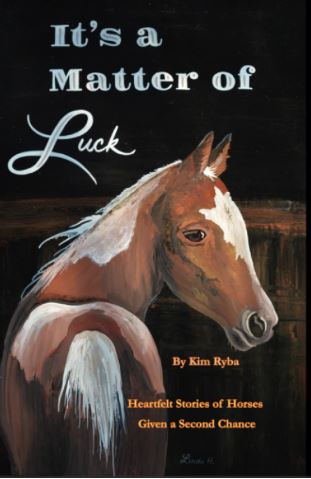
It's a Matter of Luck: Inspirational, Heartfelt Stories of Horses Given a Second Chance.
by Kim Ryba & Lina T. Lindgren
Warning: This book may cause your eyes to water in a good way. (speaking from experience after reading it)
Please give Kim and Lina a heartfelt review on Amazon!
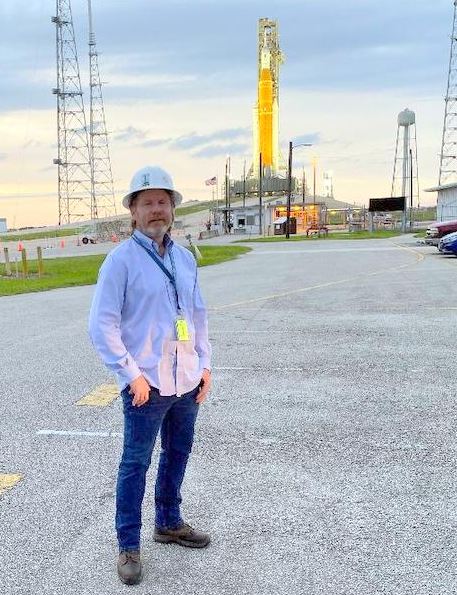
Author Bruce Ryba at Kennedy Space Center Launch Pad 39B & Artemis 1. "We are going to the Moon!"
Author's discussion (that's me) on You Tube of a book review on Amazon
For the video versions of information, please check out my YouTube Channel (Turkeys, Flintknapping, dive stories etc.)
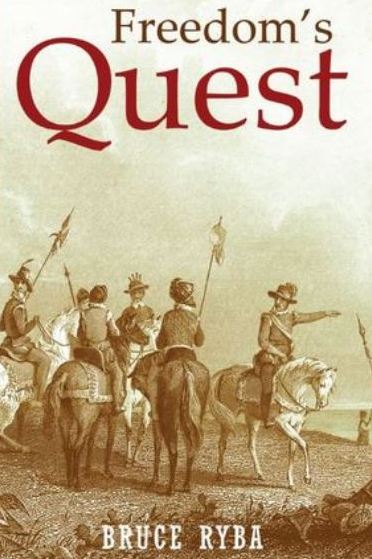
My fictional series/stories on Florida history:
Freedoms Quest (book one)
Struggle for the northern frontier and other lost tales of old Florida.
Available on Amazon
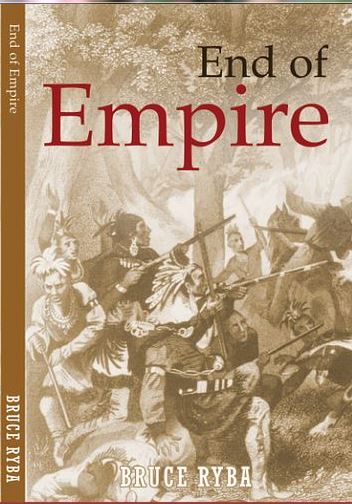
Desperate times call for bold action.
In a desperate move to retain Florida and protect the treasure-laden galleons on their dangerous return journey to Europe, the King of Spain issues a royal decree offering refuge to all English slaves who escape Florida and pick up a musket to defend the coquina walls of Saint Augustine.
In another bold gamble, the King offers refuge to the dissatisfied Indian nations of the southeast who will take up arms against the English.
Clans, traumatized by war and disease, cross the Spanish Frontier to settle the cattle-rich land and burned missions of Florida.
Follow the descendants of the conquistador Louis Castillo in remote Spanish Florida, a wild and swept by diseases, hurricanes, and northern invasions.
Book Two: End of Empire Available on Amazon!